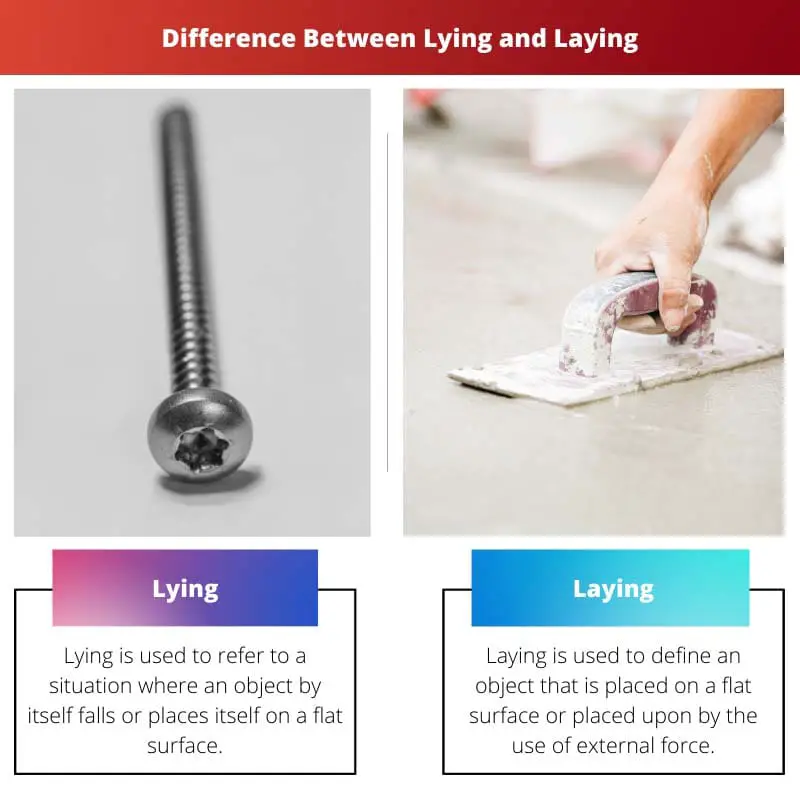The two words are confused with each other and used interchangeably, and it has created confusion over the years.
Both have similar meanings, but their area of usage differs along with how they are pronounced. Lying and laying are used to refer to placing something flat on a surface.
Key Takeaways
- “Lying” is an intransitive verb that means to be in a horizontal or reclining position, while “laying” is a transitive verb that requires an object, meaning to put or place something down.
- “Lying” also has a secondary meaning: to make a false statement intentionally.
- To use these verbs correctly, remember that “lying” does not take a direct object, while “laying” requires one.
Lying vs Laying
Lying is an intransitive verb and originated from the verb “lie,” which means to be in a horizontal or resting position, to tell an untruth, or to remain hidden or inactive. For example, “I am lying in bed.” Laying is a transitive verb and originated from the verb “lay,” which means to place something down or to put something in a particular position. For example, “I am laying the book on the table”.

Lying is used to refer to a situation where an object by itself falls or places itself on a flat surface. It is used for anything that is moving on its own.
It is an intransitive verb, meaning it does not require an object to provide meaning to the sentence it is used in.
Laying is used to define an object that is placed on a flat surface or placed upon by the use of external force.
It is a transitive verb which means it requires an object in a sentence to be present to make sense. It means that a person or a thing has to be placed.
Comparison Table
| Parameters of Comparison | Lying | Laying |
|---|---|---|
| Meaning | It is used to define an object that places itself on a flat surface or places themselves on their own. | It is used to define an object that is placed on a flat surface by a third person. |
| Past Tense | The past tense is lay, which creates a lot of confusion. | The past tense is laid, and it has been a reason for chaos. |
| Kind of verb | It is an intransitive verb which means it does not require an object. | It is a transitive verb which means it requires an object to act upon. |
| How to remember | The word lying has an emphasis on L and therefore is in conjugation with recline. | The word laying has an emphasis on A and therefore goes with its definition to place. |
| Examples | The fat cat is lying on the sofa. As soon as she comes home, she likes lying down on the sofa. | The bird is laying eggs. She is laying her bag on the floor. |
What is Lying?
According to the dictionary, lying means to place yourself flat onto some surface. It is done by itself and does not require a third person to do so.
It is a verb and is categorised under an intransitive verb. Examples:-
- I am lying on the floor.
- Rita likes lying on the sofa.
Intransitive Verb:-
A verb is a word that describes any action that has been done physically or mentally, directly or indirectly. By definition, intransitive verbs are those which do not require an object to act upon.
If they are used in a sentence, they can give a meaning without the person specifying on which the person has laid.
Example:-
- John likes lying after a hectic day.
The word lying can be used in many different forms. The most confusing form of the word is the past tense. The past tense is lay, which has created chaos for laying. Other forms of lying that are used commonly are
- Lie
- Lay
- Lain
- Have lain
There is an easy trick to remember the meaning of lying, which is the word stresses on the syllable “L”, which is in conjugation with the stress syllable of its meaning which is recline which means to push yourself on a flat surface.

What is Laying?
According to the dictionary, laying means to push someone or something on the floor. It requires a third subject to do the activity; the subject always requires an object.
It is an action verb and is sub-categorised under a transitive verb. Example:-
- The hen is laying eggs.
- After coming from school, she does not like laying her school items on the floor.
Transitive Verb:-
An action verb is a verb that describes any activity done by a subject whether it is physical or mental. With further reference, transitive verbs are those action verbs that require an object to act upon.
It means that the sentences seem incomplete until the subject has no object to act upon. For example, the sentences would be incomplete in the above sentences if no object is floor and eggs.
Many forms of verbs can be used, like past, present, future, etc. Some forms which can be used are as follows:-
- Laid
- Lay
- Been laid
- Have laid
The word is also in conjugation, which it’s meaning and helps in remembering it easily. The word’s stress syllable is ‘A’, which resembles the stress syllable in its meaning which is to place.

Main Differences Between Lying and Laying
- The meaning of the word lying is to place oneself on a flat surface without the help of others, while laying means to place something on a flat surface by a third person.
- The confusion has been very big about the past tense of lying and laying. The past tense is lay, which creates a lot of confusion, and the past tense of laying is laid.
- Lying is an intransitive verb that means it does not require an object to give meaning to a sentence, whereas laying is a transitive verb that always requires an object to act upon.
- The meaning of both words goes in conjugation with the stress syllable of the word. The stressed syllable of lying is L, and the meaning is to recline, and laying is A, and the meaning is to place.
- Examples of the following words are:
- Lying:-
- The fat cat is lying on the sofa.
- As soon as she comes home, she likes lying down on the sofa.
- Laying:-
- The bird is laying eggs.
- She is laying her bag on the floor.




